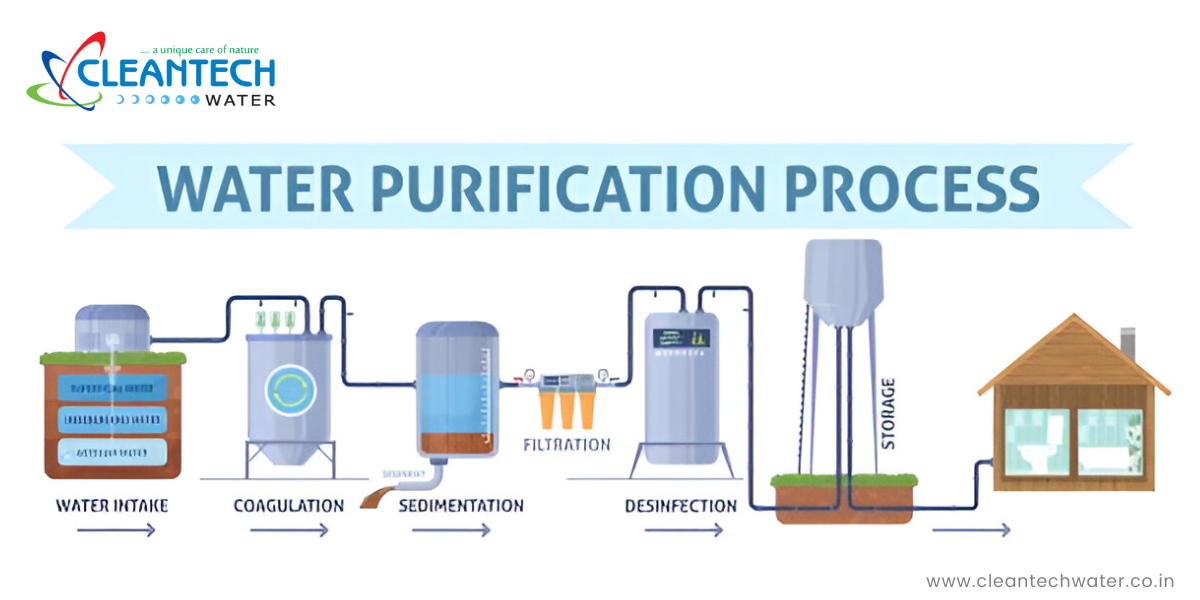Sewage disinfection plays a crucial role in ensuring the safety and health of communities, particularly in industrialized and urban areas. Proper sewage treatment is essential to protect water resources, public health, and the environment from harmful pathogens and contaminants. Effective disinfection techniques are therefore a key aspect of any sewage water treatment plant. In this context, ozone and chlorine are two commonly used disinfectants in wastewater treatment plants.
This comparative study aims to examine the effectiveness, benefits, and limitations of both ozone and chlorine in sewage treatment plants. By understanding these technologies, property owners, businesses, and individuals looking for packaged sewage treatment plant solutions can make informed decisions about the best disinfectant choice for their needs.

Overview of Ozone as a Disinfectant
Chemical Properties of Ozone (O₃)
Ozone (O₃) is a highly reactive and unstable molecule composed of three oxygen atoms. It is a powerful oxidizing agent, more potent than chlorine, and is primarily used for disinfection due to its ability to break down contaminants at the molecular level. In its gaseous form, ozone is unstable and quickly decomposes into oxygen (O₂), making it an environmentally friendly option for disinfection.
Mechanism of Action in Sewage Disinfection
Ozone works by disrupting the cellular structure of microorganisms, rendering them unable to reproduce or cause harm. As ozone comes into contact with harmful bacteria, viruses, and other pathogens in the sewage water, it oxidizes their cell walls and genetic material. This process ensures the inactivation of a wide range of harmful microorganisms, including those that are resistant to other disinfectants.
The high oxidative potential of ozone allows it to destroy pathogens without leaving harmful residues. It also works quickly, making it ideal for use in sewage treatment plants that require rapid disinfection.
Advantages of Ozone Use
- Effective at Lower Concentrations: Ozone can inactivate a broad spectrum of microorganisms, including viruses, bacteria, and protozoa, with fewer chemicals.
- No Chemical Residues: Unlike chlorine, ozone decomposes into oxygen after disinfection, leaving no harmful by-products.
- Superior Performance: Ozone is highly effective in treating wastewater that contains a variety of contaminants and can even help remove organic compounds, improving overall water quality.
- Environmentally Friendly: As ozone naturally decomposes into oxygen, it is considered an environmentally safe disinfectant with no long-lasting environmental impact.
Overview of Chlorine as a Disinfectant
Chemical Properties of Chlorine (Cl₂)
Chlorine (Cl₂) is one of the most commonly used disinfectants in wastewater treatment plants. It is a yellow-green gas that can be dissolved in water to form hypochlorous acid (HOCl), which is the active disinfectant responsible for killing microorganisms. Chlorine is widely used due to its availability, cost-effectiveness, and proven ability to eliminate a variety of pathogens.
Mechanism of Action in Sewage Disinfection
Chlorine disinfects by releasing hypochlorous acid into the sewage water. This acid penetrates the cell membranes of microorganisms, disrupting their enzymatic systems and destroying their ability to replicate. Chlorine is effective against a broad range of pathogens, including bacteria, viruses, and protozoa. However, its effectiveness can be influenced by factors such as pH levels, temperature, and the presence of organic matter in the water.
Advantages of Chlorine Use
- Cost-Effective: Chlorine is relatively inexpensive compared to other disinfectants, making it a popular choice for large-scale sewage water treatment plants.
- Proven Efficacy: Chlorine has a long track record of success in disinfecting sewage and wastewater, with reliable results when properly applied.
- Residual Protection: Chlorine can remain in the treated water, providing residual disinfection during distribution, which is particularly useful in larger systems or municipal treatments.
Comparison of Ozone and Chlorine
When it comes to selecting the ideal disinfectant for a sewage water treatment plant, understanding the comparative advantages and limitations of ozone and chlorine is critical. Both offer effective pathogen removal, but they differ in terms of effectiveness, disinfection time, environmental impact, and cost. Here’s a closer look at these factors:
Effectiveness in Pathogen Removal
Both ozone and chlorine are highly effective in eliminating a wide range of pathogens in sewage plants. However, ozone tends to outperform chlorine in certain areas.
- Ozone is known for its broad-spectrum efficacy. It is effective against even chlorine-resistant microorganisms, such as some protozoa and viruses. Additionally, ozone has superior oxidizing power, allowing it to break down complex organic contaminants, which makes it a powerful solution for improving overall water quality.
- Chlorine, on the other hand, is very effective against common bacteria and viruses, but its efficiency can be compromised by high organic content or high turbidity in sewage water. Chlorine requires longer contact times to achieve full disinfection, especially in challenging wastewater environments.
Disinfection Time and Efficiency
- Ozone works much faster than chlorine. It achieves rapid disinfection due to its strong oxidizing properties, typically requiring shorter contact times—often just a few minutes. This makes ozone a more efficient solution for large-scale sewage treatment plants that need quick turnover and reliable results.
- Chlorine tends to have a slower disinfection process. The contact time required for chlorine to effectively neutralize pathogens can vary depending on the specific water conditions. In general, chlorine-based systems need longer exposure to achieve the same level of disinfection, which can increase operational time and resource use.
Environmental Impact and By-Products
- Ozone is considered more environmentally friendly. After performing its disinfecting task, ozone decomposes into oxygen, leaving no harmful residual chemicals. This makes ozone ideal for wastewater treatment plants that prioritize sustainability and environmental safety.
- Chlorine, while effective, poses some environmental challenges. It can form harmful by-products such as chloramines and trihalomethanes (THMs), which may have adverse health and environmental effects. These by-products can persist in the treated water, requiring additional treatment steps to eliminate them and ensure safe water quality.
Cost Comparison
- Chlorine is generally more affordable in terms of initial investment and operational costs. It is widely available, and the equipment needed for disinfection is typically less expensive than that required for ozone generation. For large treatment plants, chlorine can be a cost-effective solution, especially when the treatment process doesn’t require advanced technology or rapid turnover.
- Ozone systems, while more expensive to install and operate, are often considered the better long-term investment for certain applications. Though ozone equipment and energy costs are higher, the reduction in chemical by-products and the efficiency in pathogen removal can lead to fewer long-term expenses, especially in environmentally conscious or high-demand settings.
Contact Us for a Free Quote
Health and Safety Considerations
When selecting a disinfectant for a sewage water treatment plant, safety considerations are paramount. Both ozone and chlorine can pose health risks if not properly managed, but their potential dangers and safety protocols vary.
Ozone Safety Concerns (Toxic Exposure, Handling)
- Toxic Exposure: While ozone is highly effective as a disinfectant, it is a toxic gas at high concentrations. Breathing in high levels of ozone can lead to respiratory issues, eye irritation, and other health concerns. It is essential to monitor ozone levels carefully within the treatment facility to prevent accidental exposure to workers or residents in the surrounding area.
- Handling: Ozone is typically generated on-site using specialized equipment, such as ozone generators, which must be maintained regularly to ensure they are functioning safely. Proper ventilation systems are essential to avoid the buildup of ozone gas in confined spaces, and workers must be equipped with protective gear during maintenance or repair tasks.
Chlorine Safety Concerns (Corrosiveness, Toxicity)
- Corrosiveness: Chlorine is a highly corrosive substance, capable of damaging metals, equipment, and even concrete surfaces over time. The handling and storage of chlorine require specialized equipment, including corrosion-resistant materials and secure storage tanks. Operators must ensure that chlorine is properly stored and transported to minimize the risk of accidental leaks.
- Toxicity: Chlorine gas, if released into the air, can be extremely toxic. Inhalation can cause severe respiratory distress, and prolonged exposure can lead to long-term health problems. In case of leakage, immediate action must be taken to evacuate personnel and mitigate the exposure. Chlorine must be handled with care, and the storage areas should be equipped with emergency leak detection systems and alarms.
Regulatory Standards and Guidelines
Both ozone and chlorine use in sewage treatment plants must comply with strict safety regulations set by environmental and health authorities. In India, the Central Pollution Control Board (CPCB) and the Bureau of Indian Standards (BIS) provide guidelines for the safe use of disinfectants in wastewater treatment. Compliance with these standards ensures that water treated with chlorine or ozone is safe for discharge into the environment or reuse.
Facilities must also follow worker safety regulations, including occupational health standards for exposure to both ozone and chlorine. Regular safety audits and training programs are essential to maintaining a safe working environment.
Operational Factors
Equipment and Infrastructure Requirements
- Ozone systems require sophisticated equipment such as ozone generators, oxygen concentrators, and specialized piping for distribution. This makes the initial setup cost higher than chlorine systems. In addition, packaged sewage treatment plant solutions incorporating ozone may need additional infrastructure to ensure proper ozone generation and circulation throughout the system.
- Chlorine, on the other hand, requires simpler infrastructure, such as chlorine gas cylinders or liquid chlorine storage tanks, and dosing systems for accurate application. While the setup is less costly, chlorine systems still need to be maintained to avoid potential safety issues, such as leaks or corrosion.
Ease of Use and Maintenance
- Ozone systems are generally more complex to operate and maintain. They require regular checks on equipment such as ozone generators, oxygen concentrators, and safety systems to ensure that ozone concentrations are within safe limits. Maintenance staff must be trained in both the technical and safety aspects of ozone treatment to avoid risks.
- Chlorine systems, while simpler in design, also require regular monitoring to ensure correct dosages and to check for leaks. Chlorine systems require more frequent maintenance due to the corrosive nature of chlorine and the wear on storage equipment. Regular inspections and replacement of old components are necessary to maintain safe and efficient operations.
Training Requirements for Operators
Both ozone and chlorine require specialized training for operators, though ozone systems generally require more in-depth knowledge due to their complexity. Operators must be trained in the safe handling of chemicals, the operation of disinfection equipment, emergency response protocols, and regulatory compliance.
In the case of chlorine, operators should be trained in managing the risks associated with toxicity and corrosion, as well as in the proper storage and transportation of chlorine. Given the hazardous nature of both substances, proper training is crucial to ensure the health and safety of both workers and the surrounding community.
Environmental Impact
When considering the environmental impact of disinfectants used in a sewage water treatment plant, both ozone and chlorine have distinct profiles.
Ozone’s Role in Reducing Chemical Pollutants
Ozone is a powerful, natural oxidizer that decomposes into oxygen after use, leaving no harmful chemical residues behind. This makes ozone an environmentally friendly choice for sewage plants. Its ability to break down organic contaminants without producing by-products like chlorine’s chloramines or trihalomethanes (THMs) significantly reduces chemical pollution. As a result, ozone helps in producing cleaner, safer treated water while minimizing the risk of environmental harm.
Chlorine’s Environmental Footprint and Toxicity
While chlorine is effective at disinfecting sewage, its environmental footprint is more concerning. Chlorine-based disinfection can result in harmful by-products, such as chloramines and THMs, which are toxic and may persist in water sources. These by-products can negatively impact aquatic ecosystems, affecting fish and other wildlife. Additionally, chlorine’s corrosive nature can damage aquatic habitats and infrastructure. Over time, this can lead to the need for additional treatment processes to remove these toxic compounds, adding to the environmental burden.
Choose the Best Sewage Water Treatment Plant Solution Today!
Investing in the right sewage water treatment plant is crucial for both environmental sustainability and long-term operational efficiency. Whether you’re a business owner, property manager, or part of a community initiative, selecting the best treatment solution can make a significant difference. By opting for advanced options like packaged sewage treatment plants with ozone disinfection, you can ensure that your treated water meets the highest safety standards while minimizing environmental impact.
Don’t settle for outdated, inefficient systems. Upgrade to modern, effective solutions from Cleantech Water that provide rapid pathogen removal, reduce chemical pollutants, and align with global safety regulations. With our tailored sewage treatment plant options, you’ll be equipped with the technology and expertise needed to maintain clean, safe water. Contact us at +91-9099915539 or +91-9558996411 for queries.

